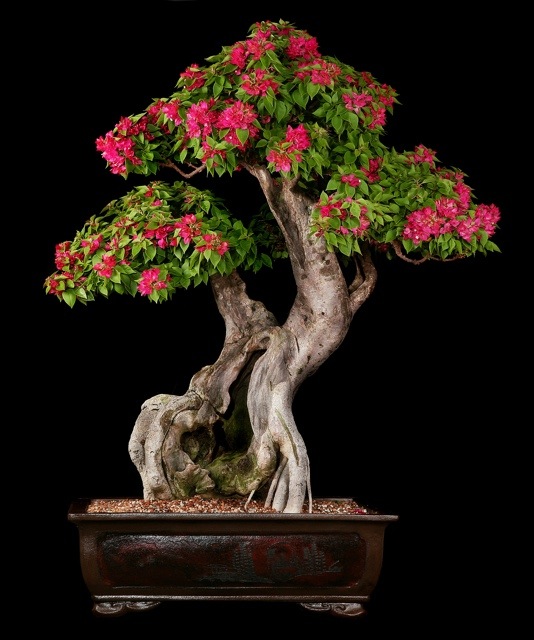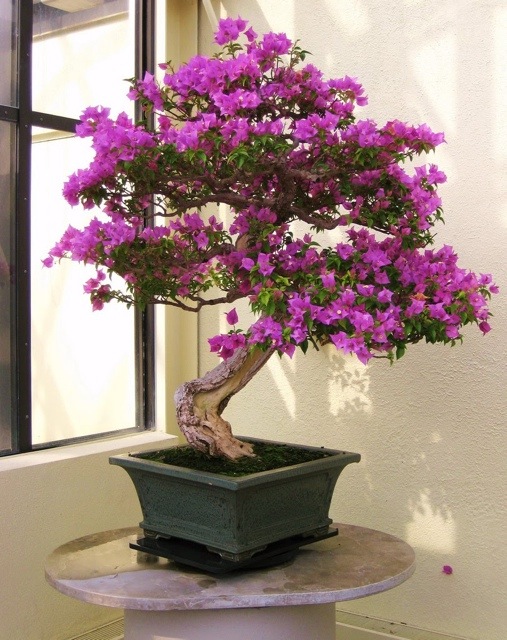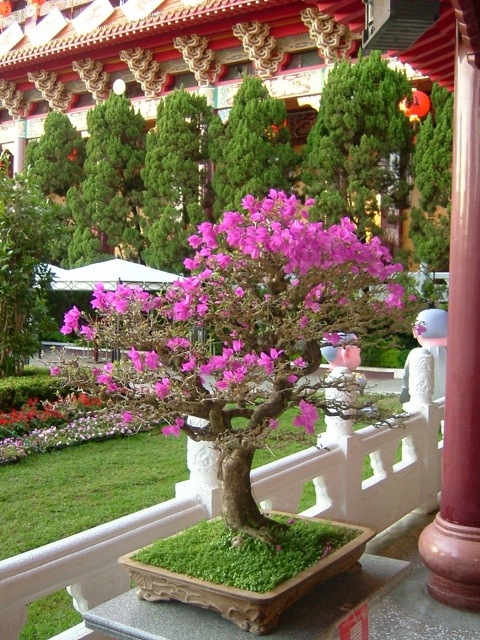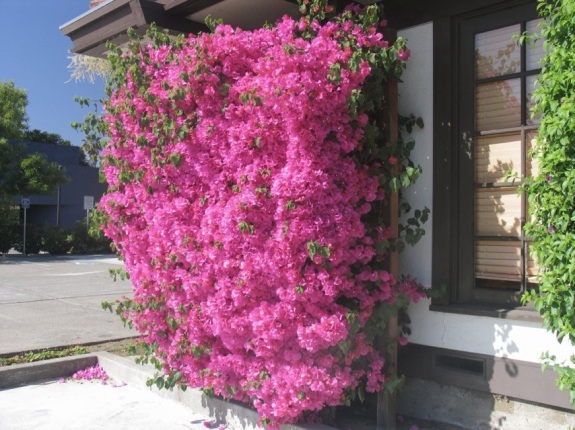bou·gain·vil·le·a [boo-guhn-vil-yuh; -vil-ee-uh; boh-]
Introduction
The Bougainvillea is an immensely showy, floriferous and hardy plant. Virtually pest-free and disease resistant, it rewards its owner with an abundance of color and vitality when it is well looked after. The bougainvillea’s versatility is legendary. It can be coaxed into a small manageable pot plant or a sizeable tree, to spread itself vertically on a wall, or climb up a trellis and form a luscious crown or burst forth into graceful arches. It makes one of the best hedges, bushes, and curb-liners. And as for bonsai or topiary purposes, it has few equals, lending its complex branching to the pruning shears, which promote even more unique and graceful forms. It is probably true to say that without the bougainvillea, our roads, parks, and private gardens would be a lot less colorful that what we see today. Almost everywhere we go, its brilliant hues and cheerful bursts punctuate the lush green mantle that cloaks our tropical environment. Other flowering plants certainly pale in comparison.
A woody clambering vine, bougainvillea will stand alone and can be pruned into a standard, but it is perfect along fence lines, on walls, in containers and hanging baskets, and as a hedge or an accent plant. Its long arching branches are thorny, and bear heart-shaped leaves and masses of papery bracts in white, pink, orange, purple, and burgundy. Many cultivars, including double flowered and variegated, is available.
History
A native to coastal Brazil, the bougainvillea was discovered in 1768 in Rio de Janeiro by French naturalist Dr. Philibert Commerçon (also sometimes spelled Commerson). The plant is named after his close friend and ship’s admiral Louis-Antoine de Bougainville, who commanded the ship La Boudeuse that sailed around the world between 1766-1769, and in which Commerçon was a passenger.
Twenty years after Commerçon’s discovery, it was first published as ‘Buginvillea’ in Genera Plantarium by A.L. de Jusseau in 1789. The genus was subsequently split in several ways until it was finally corrected to ‘Bougainvillea’ in the Index Kewensis in the 1930s. Originally, B. spectabilis and B. glabra were hardly differentiated until the mid 1980s when botanists recognized them to be totally distinct species. In early 19th century, these two species were the first to be introduced into Europe, and soon, nurseries in France and England did a thriving trade providing specimens to Australia and other faraway countries. Meanwhile, Kew Gardens distributed plants it had propagated to British colonies throughout the world. Soon thereafter, an important event in the history of bougainvillea took place with the discovery of a crimson bougainvillea in Cartagena, a Spanish port in the Mediterranean, by Mrs. R.V. Butt. Originally thought to be a distinct species, it was named B. buttiana in her honour. However, it was later discovered to be a natural hybrid of a variety of B. glabra and possibly B. peruviana – a “local pink bougainvillea” from Peru. Natural hybrids were soon found to be common occurrences all over the world. For instance, around the 1930s, when the three species were grown together, many hybrid crosses were created almost spontaneously in East Africa, India, the Canary Islands, Australia, North America, and the Philippines.
Scientific classification
Kingdom – Plantae
Division – Magnoliophyta
Class – Magnoliopsida
Order – Caryophyllales
Family – Nyctaginaceae
Genus – Bougainvillea
Species – Bougainvillea spectabilis
Bougainvillea glabra
Bougainvillea peruviana
Cultivar (or variety)
Note about Species: Many of today’s bougainvillea are the result of interbreeding among only three out of the eighteen South American species recognized by botanists.
Note about Cultivars: Currently, there are over 300 varieties of bougainvillea around the world. Because many of the hybrids have been crossed over several generations, it’s difficult to identify their respective origins. Natural mutations seem to occur spontaneously throughout the world; wherever large numbers of plants are being produced, bud-sports will occur. This had led to multiple names for the same cultivar (or variety) and has added to the confusion over the names of bougainvillea cultivars.
Best Climate for Bougainvillea.
Bougainvillea thrives in full sun. At least 5 hours a day of full sunlight is the minimal light required for good bloom. More hours of direct sun are better. Less than 5 hours and the plant may not bloom very well. In shade or partial shade, you will have nice vegetative growth, but little or no bloom. A Bougainvillea just doesn’t bloom well indoors. If possible, keep your plant outdoors (in the maximum sun available). If placed on a porch, patio or balcony, where the plant receives at least 5 hours of sun each day (afternoon sun is best), then it should bloom ok. A bougainvillea likes high humidity just before it comes into bloom. Once bloom has been initiated, then it will tolerate less humidity.
Light Levels
As a tropical plant, Bougainvillea requires full sun, or a light level of at least 4000 f.c.
Media
Bougainvillea has an extremely fine root system, and should be planted in well-drained soils. Avoid soil mixes with high peat levels and water retention. These types of media retain too much water and will contribute to root rot; be sure to select a well-draining media. The best growing mixture is one that is soil-less. Soil-less media are free of any disease pathogens, insect pests, and weed seeds. They are also generally lightweight and porous, allowing for a well-drained yet moisture-retentive mix. Premixed growing media are available from garden centers. However, be careful not to use peat or peatlite mixes alone. By themselves, these media tend to become compacted, too lightweight, and hard to wet. The greatest problem with peat/peatlite mixes is when the soil dries completely, the root ball will pull away from the side of the pot, and it is almost impossible to completely wet the soil again — the water simply runs down the side of the container and drains out the bottom. If your plant dries out and you use this type of mix, to rewet it, let the pot sit in a pail of water until the soil ball is completely wet. Before using your mix to repot plants, be sure it is damp. Totally dry soil mixture is difficult to handle and may damage tender roots before the plant is watered.
Fertilization
Bougainvillea are heavy feeders that require regular monthly fertilization. Nitrogen and phosphate are critical to flowering, but do not overfertilize with these two elements because it will add growth and inhibit blooming. This is the case when using generalized fertilizers like a 20-20-20 or 12-12-12. That’s why we’ve created a blooming fertilizer specifically for bougainvillea called BOUGAIN®. With Bougain’s 6-8-10 plus Minors formula, Nitrogen levels are just right for flowering, but low enough to limit excessive green growth. In addition, Bougain® contains 5% Iron — and any professional grower will tell you that’s the secret for vibrant, beautiful color on bougainvillea.
Pruning & Pinching
Bougainvillea may be pruned at any time of the year. Bloom initiation does not depend upon pruning – a bougainvillea has a bloom cycle followed by a rest period whether pruned or not. A hard prune is recommended when you need to contain growth or when you are preparing to move your bougainvillea indoors for the winter. The ‘Soft Prune’ is recommended for bougainvillea only when trying to obtain a special form. A bougainvillea, like most vining-type plants, will continue to grow outward without sending out side branches from each leaf-bud point unless the stem is pinched. If you want one long stem, then don’t pinch out the tip. By pinching out the tip, most bougainvillea cultivars will send out new stems from 2 to 3 leaf-buds below the cut. Some varieties do not send out any new stems, so their appearance is always stringy or bare. It’s important when growing a bougainvillea, not to wait for the branches to grow very far beyond your desired size before you remove all the tips — otherwise, the growth will be bare in the center of the plant, and the overall look will be misshapen.
Growth cycles
The bougainvillea has two distinct growth cycles:
1. A vegetative growth period for several weeks — when new leaves and stems grow. If the plant receives enough sunlight, the plant will form buds during this time. If there is not enough sunlight, the plant will remain in vegetative cycle.
2. A blooming period of several weeks when little or no vegetative growth occurs. The length of time they will display color is dependent upon the health of the plant and the environment they are in; the more sun and heat, the better.
Photoperiod/Flowering
Blooms occur only on new growth, so new growth on plants is vital to the achievement of flowering. Bougainvillea normally flowers during the short days of winter, but blooms are highly dependent on temperature. Drought stress can also stimulate flowering even with long daylight exposure. Growers frequently allow plants to dry just to the point of wilting to induce flowering. However, excessive drying can cause leaf drop and dormancy; use care and be sure to water at first signs of wilt.
Landscape Culture
Bougainvillea is a wonderful addition to any landscape, whether it’s used as a permanent fixture, a container plant or hanging basket in a semi-tropical landscape, or an annual in cooler climates. For the best performance out of your Bougainvillea, follow these guidelines:
Keep Bougainvillea on the dry side, especially if you want lots of blooms. Too much water will promote root rot and cause leaves to drop. Don’t water on cool nights.
Use a high-bloom fertilizer.
Plant or place Bougainvillea in full sun. As a potted plant, flowers will last for up to eight weeks if kept in a sunny location.
Bougainvillea is a vine and new growth (after a prune) starts one or more leafbuds below the cut and not up and down the entire branch. By doing a “hard” prune, next spring, when the plant regrows it will be fuller from the base up. Most reference to pruning bougainvillea I have found on the web is applicable more to nonvining plants where new branches grow up and down the stem after a pinch — vines or climbing plants tend to grow only one or two branches from the leafbuds just below the cut after pruning. If you like the shape of your plant now, then you may not even want to prune before moving it indoors. Next spring it will hold the same shape, just grow larger. But, if is not quite the shape you desire or is overgrown, the best thing to do would be to perform a hard prune.
Planting In Containers
Generally, bougainvillea can be grown in anything that will hold soil and allow proper drainage. Some of the more traditionally used containers include terra cotta (clay) pots, plastic pots, hanging baskets, wire baskets lined with sphagnum moss or fibrous liners, concrete planters, planter boxes, and bushel baskets. In Southeast Asia, we saw beautiful bougainvillea growing out from old laundry baskets and tires! Just remember that the container MUST have proper drainage. If you place your pot directly on the ground, the roots may emerge from drainage holes and find their way into the earth. To prevent this, place wooden slats or four bricks (in a T-design) under the pot. The air will naturally prune the roots that are exposed.
It’s very important to remember that a bougainvillea does not tolerate standing in water. Whatever container you choose, consider these tips:
Drainage: Bougainvillea must have it.
Insulation: Avoid using black containers in full sun.
Large enough: The container must be large enough to hold the minimum amount of soil required for mature plants to grow in.
Weight: Will it be too heavy to move? Styrofoam peanuts can be used in the bottom of the container rather than filling it fully with soil mix. This should also help with drainage and keeping drainage holes clear of debris.
Repotting Bougainvillea
A bougainvillea blooms best when pot-bound so do not be tempted to re-pot unless you must. It is best to leave the plant in its original container until the roots have replaced all of the soil and you can’t keep the plant well watered. For example, it is not unusual to grow a bougainvillea in a 1 gallon pot for three or more years. When it is necessary to re-pot remember that a bougainvillea has a very delicate root system and a fragile root to stem connection. Handle bougainvillea with care. Root pruning is not recommended when re-potting bougainvillea – in fact, disturb the roots as little as possible because the plant might go into shock and take weeks to recover. Bougainvillea love to be pot-bound, so pot in the smallest container available for the purpose you desire. Re-pot into larger pot sizes gradually. For example, move a plant in a 6″ pot into a 9″ or 10″ pot. Several years later, you can then move up to a 14″ pot. The root system needs time to grow into each new pot.



